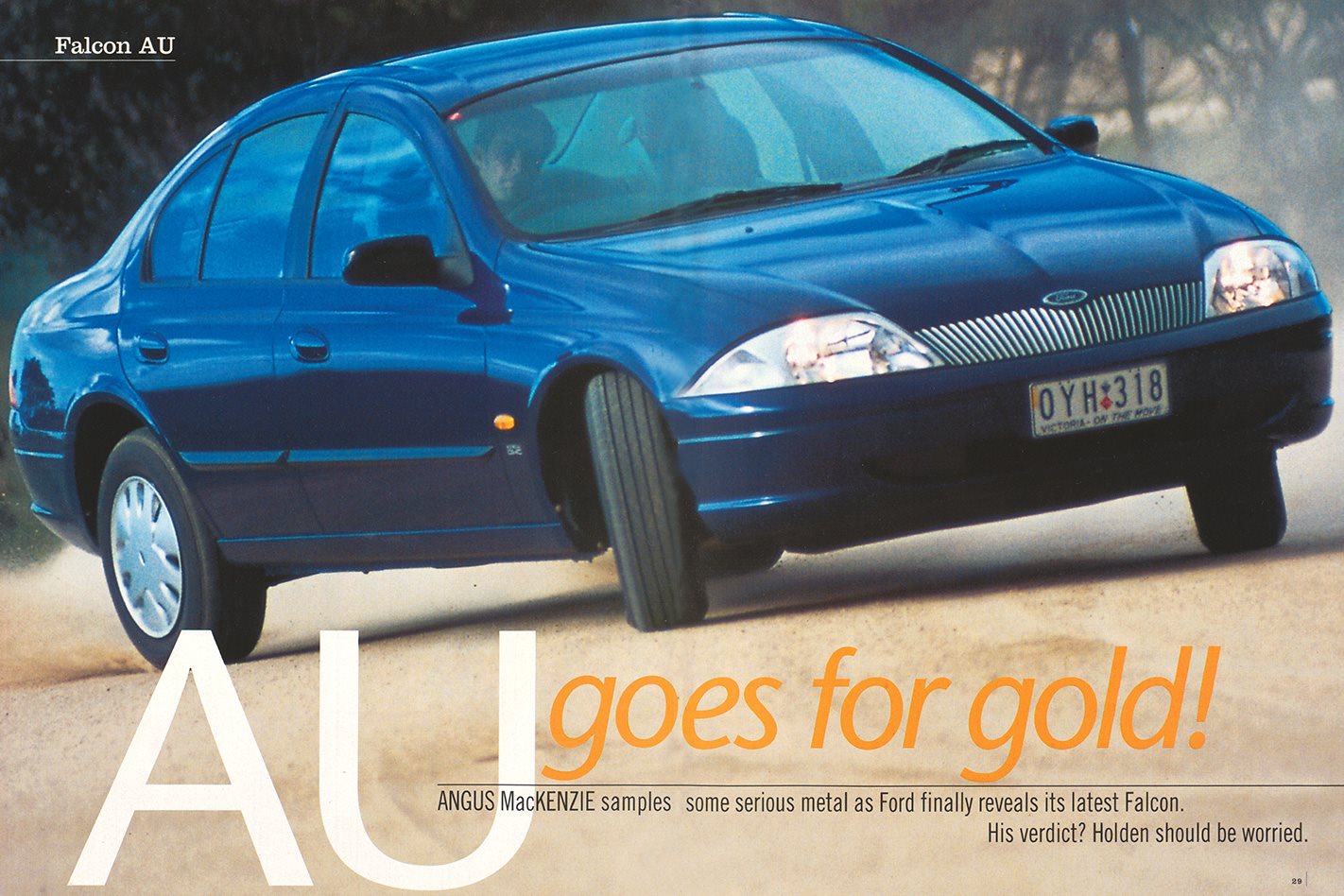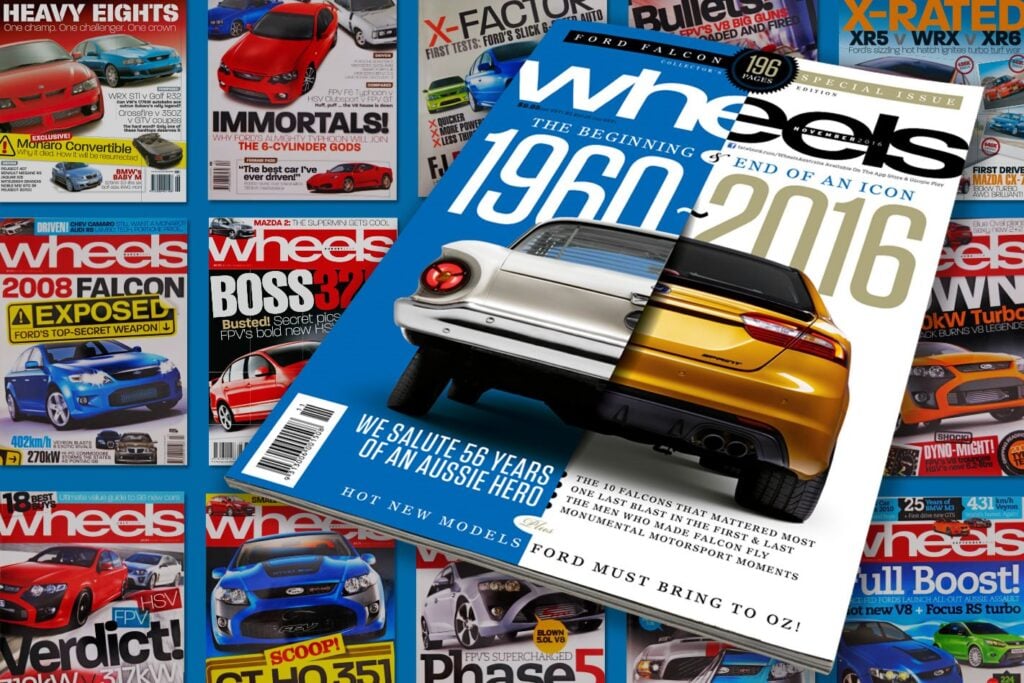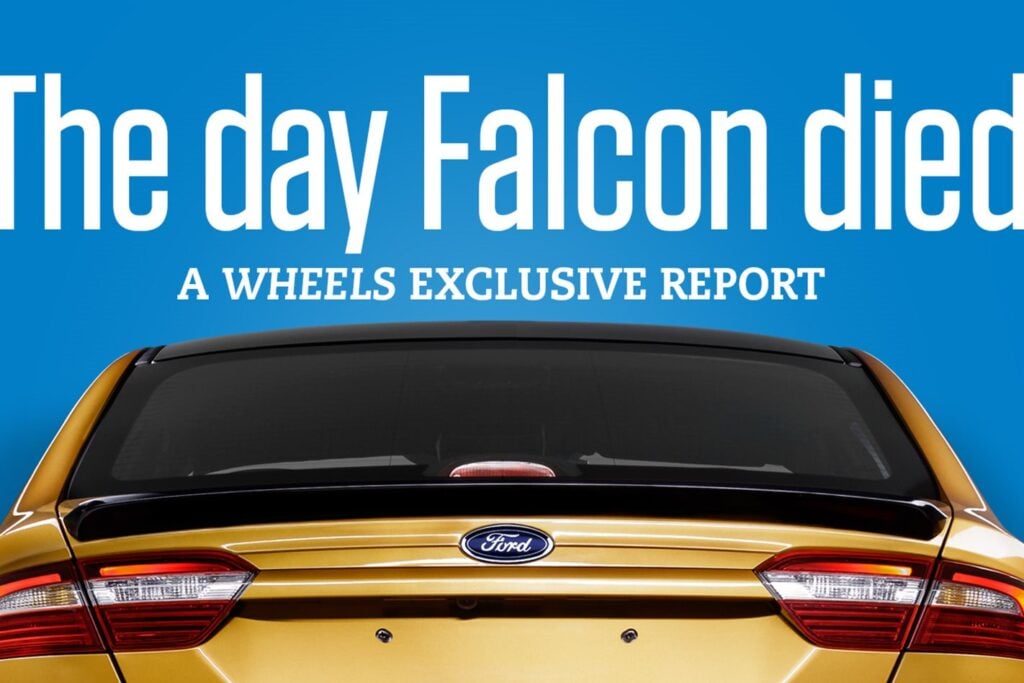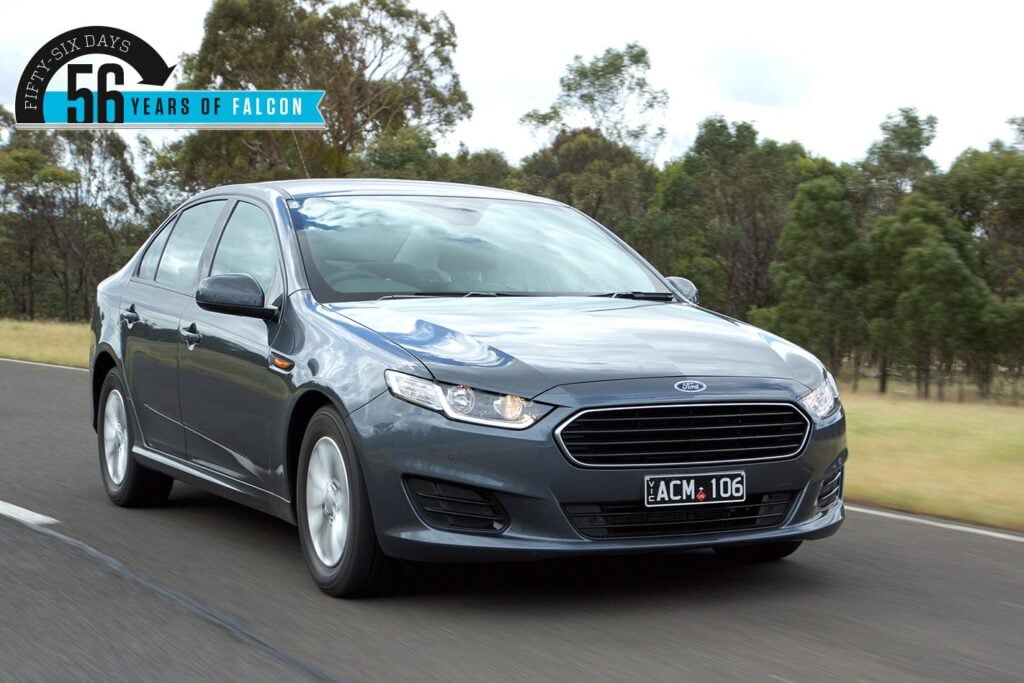ANGUS MacKENZIE samples some serious metal as Ford finally reveals its latest Falcon. His verdict? Holden should be worried.
First published in the October 1998 issue of Wheels magazine, Australia’s best car mag since 1953.
“It’s really only once every 10 years we get the chance to make a big change to the Falcon.”
Ian Vaughan, Ford Australia‘s vice-president of product development, and the man responsible for the new AU Falcon, is a master of understatement.
Big change?
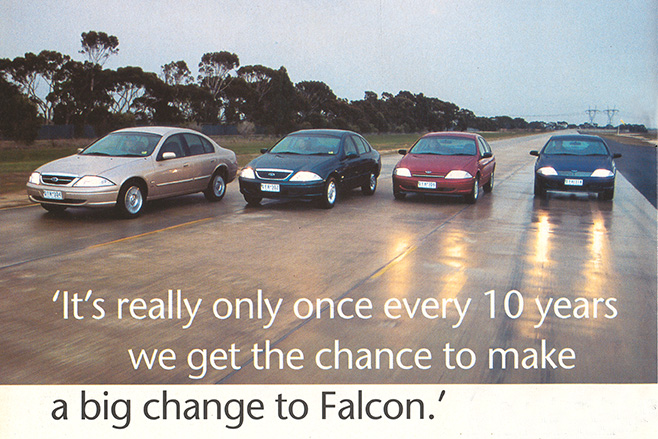
If you’ve driven Falcons before, there’s a lot about the AU that will seem familiar.
Although it looks tighter, tauter, smaller than before the AU retains the current Falcon package size inside and out, plus or minus a few millimetres here and there.
Base engine is still a 4.0 litre inline six- with the same bore centre spacings that every Falcon six has had since 1960 – driving through BTR’s electronically controlled four-speed auto. It’s quieter and smoother, but close your eyes and the AU still sounds like a Falcon.
And yet … slide in behind the wheel and you immediately notice you’re sitting lower in the car. A virtually brand new floorpan – only parts of the cowl support and the rear rails on the sedans are carried over from the EL Falcon – means Ford has been able to drop the H-point of the front seats, making this the first Falcon you sit in rather than on.
On the road you’ll also notice the steering response is more linear, the engine revs harder and the ride is more comfortable. At first acquaintance – and we have only driven the car at Ford’s You Yangs Proving Ground – the AU takes traditional Falcon values and adds a big dollop of refinement, quality, efficiency and flair.
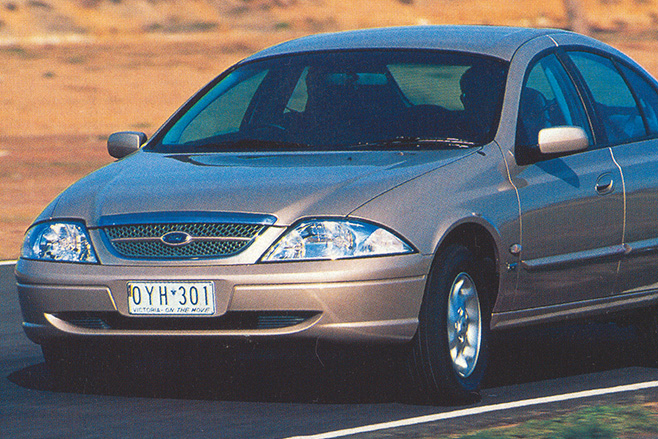
As we revealed exclusively last month, there are no fewer than four differently styled front ends and two different dash panels.
There are also seven different engine packages – five levels of tune for the six-cylinder engine, including a fully integrated LPG version, and two for the 5.0 litre V8- plus three different rear suspension layouts, including an independent double wishbone layout that is standard on Fairmont Ghia and optional on all the other sedans.
Driver’s airbag, power steering, remote central locking – this has been standard fare for the traditional Aussie six for the past few years now, and AU Falcon conforms to the norm.
While Holden VT Commodore offers electric seat height adjustment across the range, AU Falcon’s key surprise and delight feature – as the marketing mavens like to call them – is steering wheel mounted audio controls as standard equipment on all models.
Ford is also offering an optional ‘Mobile Office Pack’ which includes a small table designed to fit over the automatic transmission holder and cupholder recess to form a stable working surface for your laptop computer or paperwork, a mobile phone holder in the centre armrest, extra 12 volt power outlet, and aimable front seat reading lamps.
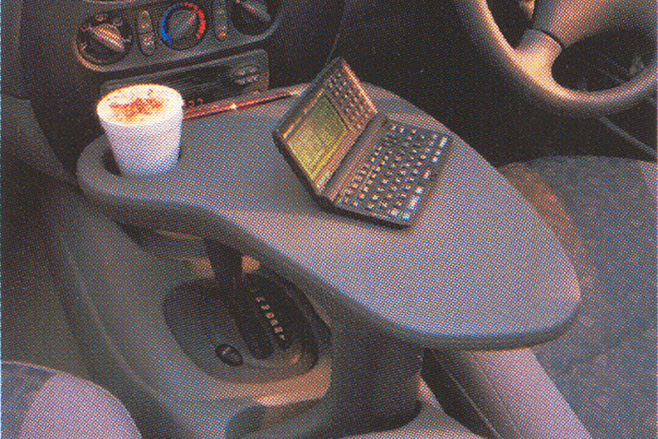
The decision to go with Forte was made quite late in the program – replacing the GLi name was not broached until last November, and approval to use Forte not given until January, recalls marketing vice president Holly Kramer – but
it makes a lot of sense from a marketing perspective.
Where Ford has been extra clever has been to give each of the AU variants a unique visual identity by mixing and matching a handful of key components, in addition to adding a bit of brightwork to the upmarket versions.
In simple terms, all cars share every panel apart from the bonnet. Forte, Futura and the XRs feature a bonnet which drops down in the centre, while Fairmont and Fairmont Ghia are fitted with a raised centre bonnet that will ultimately also appear on the long wheelbase Fairlane and LTD due next year.
Headlights are common – except on XRs – but the grille inserts are all dramatically different. The new Fairmont twins feature a more prominent evolution of the current Fairmont design, while the Futura has been given a relatively conservative narrow-mouth grille with a single chrome cross bar. But in the metal it’s the toothy Forte grin which gives the AU the strongest, freshest look.
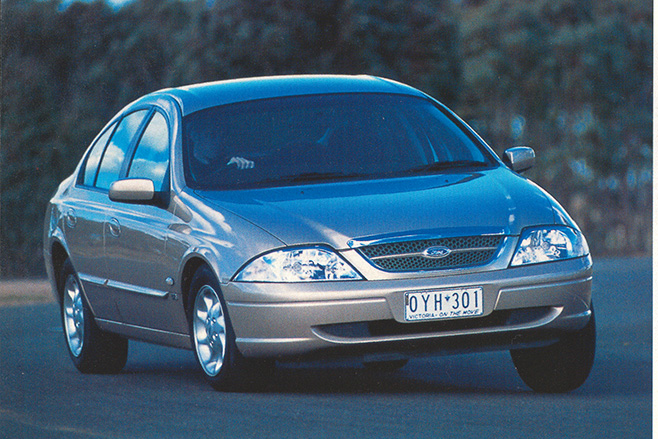
“You have to get within five feet of it to see all the design detail. The Falcon is a graphic car. You can see it 100 yards away and know exactly what it is.”
He’s right. Big lights front and rear, and a roofline that sweeps in an unbroken arch from cowl to bootlid give the new Falcon a bold, distinctive look. Compared with the current Falcon, the base of the windscreen has been moved forward about 40mm, while the rear end is some 45mm higher.
The AU is also 10mm shorter overall, with front overhang cut by 14mm, and 20mm taller.
While slightly smaller on the outside, Ford claims the subtle recasting of Falcon’s proportions has actually increased interior space – headroom is up 17mm at the front and 2.5mm in the rear; luggage space is up 1.4 litres.
There’s a hint of New Edge in the details – the way the front and rear lights are delineated, for example – but some of the more subtle creases in the surfaces have more to do with managing airflow over the sheet metal than making it look pretty.
Vehicle refinement and aerodynamics supervisor Clive Humphris says more than 350 hours of wind tunnel work have gone into honing the Falcon’s shape to the point where he claims the AU has a drag co-efficient of just 0.29.
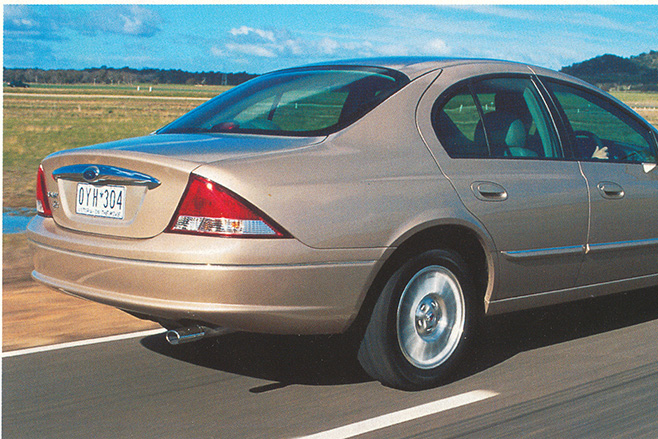
In Forte and Futura the dash follows convention in placing the instruments and controls in a built up area around the driver and rolling away to a soft, gently raduised crash pad in front of the passenger. In the Fairmonts there’s a totally different crash pad which is taller, more formal and features an insert of plastic wood.
Basic interior hardware is coloured medium graphite (light grey). A dark graphite is offered on the Fairmonts and XRs; it’s not quite black, but the closest we’ve seen on an Aussie car in 20 years, and it looks terrific.
As mentioned already, all cars feature steering wheel mounted audio controls (seek and volume) and Futura and above come standard with a large, user-friendly double DIN audio head unit which is CD and mobile phone compatible. Fairmont comes standard with a single CD player; Fairmont Ghia gets a six-disc stacker.
Forte and Futura get large rotary HV AC controls. The Fairmonts also feature high-mounted push button climate control with a display screen adjacent to the trip computer.
Falcons have always had strong showroom appeal, but Ford claims the AU will also be cheaper to own and run.

The cumulative cost of scheduled services at 90,000km has been reduced by five percent, and 10 percent at 150,000km.
Holden should be worried this Falcon is going to give the VT Commodore a hard time, although we predict the two will be so closely matched that picking the better car will come down to a model by model, dollar for dollar comparison.
The irony is that, like the VT, the AU is a far superior car than it was ever originally planned to be, albeit for vastly different reasons.
Indeed, in a quiet moment Broadmeadows insiders will admit that at one stage there was never going to be an AU Falcon at all; that was when Jac Nasser arrived in late 1989 to grapple with Ford Australia’s bloated costs and structural inefficiencies. The intention was to shut down local manufacturing altogether and replace Falcon with an import.
It was Nasser’s successor, John Ogden, who turned around the case for Falcon. Through 1993 Ogden persuaded senior brass in Dearborn that Ford needed Falcon in Australia, if for no other reason than his realisation that moving to front-wheel drive would be commercial suicide and Ford didn’t have a suitable rear-wheel drive substitute elsewhere in its global product portfolio.
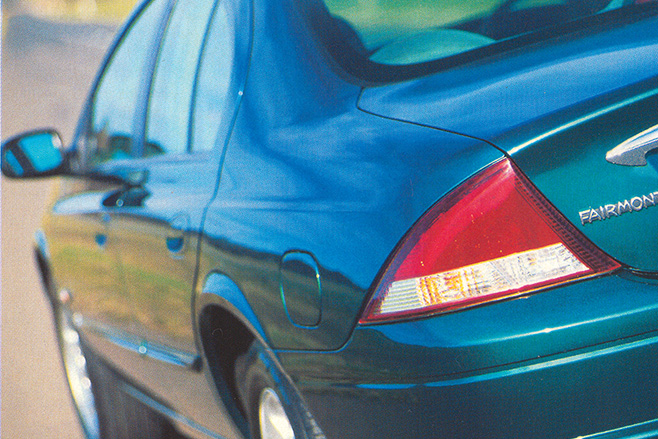
Though Alex Trotman’s radical restructuring of Ford’s global operations would ultimately make AU the car it is, initially it was almost Falcon’s death warrant.
“It wasn’t a help,” admits Ian Vaughan. “In fact it nearly bowled us out. We had to re-state the business case all over again.”
Quite simply, Falcon – and Ford Australia, for that matter – didn’t fit with Trotman’s strategy of centralised vehicle development centres and a reduced number of global platforms. But once more Dearborn was forced to conclude that while Falcon volumes were too small to influence the Big Picture, they were simply too big to be ignored.
Falcon survived, but Ford 2000 triggered the single most profound change in the way Broadmeadows operated since Jack Telnak set up the local design centre in the late 60s – all key AU design and development decisions would be controlled by Ford’s large vehicle centre in Dearborn, rather than local management.
Ian Vaughan, who had been moved into head the local AU Falcon development team, would now report directly to large vehicle centre chief Ken Kohrs in the US, as well newly appointed Ford Australia boss David Morgan.
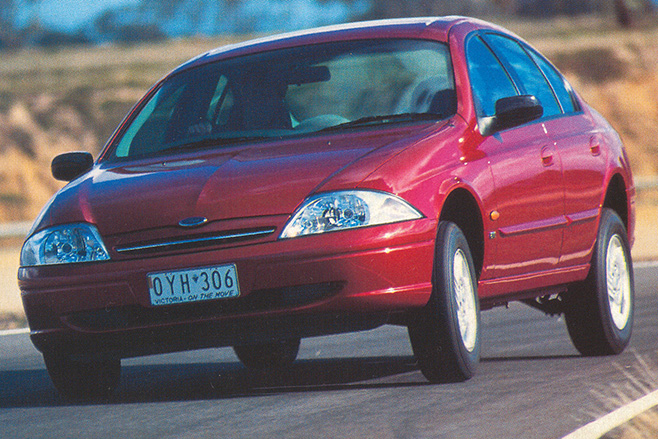
But as Ford 2000 evolved into a strategy of optimising global vehicle development resources rather than commonising vehicle hardware globally, the Australian design and engineering teams effectively became the Falcon specialists within the large vehicle centre, electronically co-located with their colleagues in Dearborn via Ford’s private satellite network.
The substantial revisions to the 4.0 litre six – now dubbed Intech – precisely illustrate just how the AU Falcon has benefitted from this process. Ford was always going to have to use the inline engine – the cost of a new engine plant was simply prohibitive – but with the support of global engine chief Jim Clark, the man responsible for the ohc modular V8, it ended up spending twice what it had originally planned on upgrades and improvements such as the new structural cast alloy sump with its integral cross-bolted main bearing support.
“It expanded our vision,” says Lindsay Dawson of a process which resulted in what is virtually a brand new engine.
“We didn’t believe we could get as good a result as we did.”
Ford engine engineering supervisor David Mitchell claims the six has been transformed. Greatly improved is a more accurate descriptor.
The Intech engine revs harder, and there’s much less harshness above 3000rpm, but it’s no BMW; despite a lot of work to reduce friction it still feels like there’s a heavy rotating mass whirring around up front.
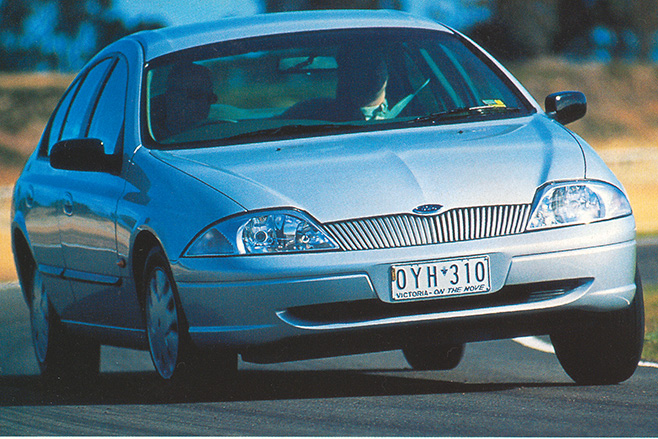
Part of the problem may be the BTR four-speed automatic, which seems a bit languid in its response.
The base Intech six develops 157kW at 4900rpm and 357Nm at 3000rpm-just like the old engine, but manages to use less fuel doing so.
The LPG version, engineered by Tickford, matches it for torque, and only loses out in terms of power above 4500rpm. There’s a high performance (HP) version of the Intech for the entry level XR6 which develops 164kW at 5000rpm and 366Nm at 3150, and then two stages of tune for the Tickford developed variable camshaft timing (VCT) version – 168kW at 5300rpm and 370Nm at 3500rpm for the engine fitted to the Fairmont Ghia, and 172kW at 5000rpm and 374Nm at 3500rpm for theXR6 VCT.
The standard 5.0 litre V8 now has six percent more power – 175kW at 4600rpm and two percent more torque – 395Nm at 3200 – thanks to upgrades flowing through from the engine’s fitment to the Explorer in the United States.
The Tickford massaged XR8 version still develops 185kW, but the power peak now occurs 500rpm up the range at 5000rpm. However torque has been boosted 10Nm to 412Nm at 3500rpm.
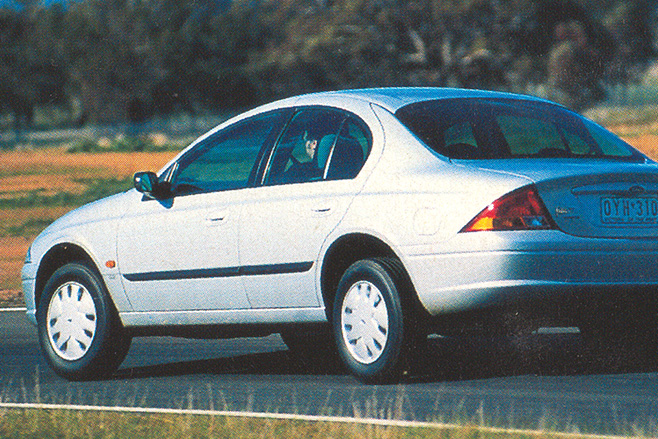
“I got told time and time again to take it out; that the customer doesn’t need it,” says Ian Vaughan. Ironically,
Vaughan believes eight out of 10 drivers probably won’t be able to tell the difference between new IRS and the well-proven Watts link live axle setup that’s standard on all but Fairmont Ghia – and within the clinical confines of the You Yangs, we’d probably have to agree – but that didn’t stop him pushing for the relatively expensive double wishbone layout.
“I didn’t want to do a trailing arm 20 years after everyone else,” he says.
Yes, we know the VT has a trailing arm rear end.
Dialling in the IRS also caused a few headaches in the AU chassis development program. Suspension ace John Mole was brought across from Tickford at the beginning of 1996 to finesse the system.
A former racer and the man behind the XR and GT suspensions, Mole found the original method of mounting the rear crossmember (to the inside of the chassis rails) allowed the whole suspension to move slightly under hard cornering, which provoked a subtle waddle at the rear, just like – he says – a BMW 528i. A new crossmember which mounted on the outside of the chassis rails well ahead of the axle line solved the problem.
Until March the IRS cars also had an 18mm rear roll bar, but this was removed after Ford’s global product chief,
Richard Parry-Jones, complained of oversteer during quick test session just prior to the Australian Grand Prix.
Parry-Jones wanted more linear, progressive handling on the limit and did not like having to wind off lock – even slightly – mid comer as the rear end came around.
The roll bar was removed and Parry –Jones subsequently drove IRS prototypes in June to ensure the chassis balance was to his satisfaction before signing off on the car.
On the smooth new handling track at the You Yangs the benefits of IRS are indeed difficult to detect. But on the old durability road – which dates back to the 1960s but is still better surfaced than most Australian country roads – we noticed better ride over small, sharp bumps and softer feel on full compression, although in the Fairmont Ghia the ride benefits were masked somewhat by the stiffer sidewall 16in Goodyear Eagle GA Plus tyres.
Late in the day John Mole took us over to a new bump track in the centre of the high speed oval where four up back-to-hack tests in a Futura and IRS Fairmont (which had similar profile 15 inch Michelin tyres) revealed markedly less side-to-side tossing of occupants and no wheel hop in the IRS car.
Regardless of rear end, the Falcon’s basic handling characteristic is understeer. It’s probably a touch more than we’d like, but we’ll have to wait until we put in some serious kays over real world roads before we make a definitive judgement.
At a total development and investment cost of $700 million, this is the most expensive Falcon ever. And yet, in a business where most new car programs are casted in billions, Ford Australia has delivered a bargain.
By any objective measure, the AU Falcon is, at first acquaintance, a world-class car with remarkably few compromises. Australia’s once unfashionable and uncompetitive car industry has again proven that with the right support it can do more with less.
In the new, globalised Ford Motor Company, that’s a message that won’t go unnoticed. But importantly, it’s one Australian drivers will quickly appreciate.
Want more? Check out our 56 years of Falcon!


